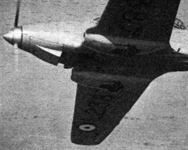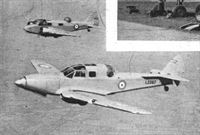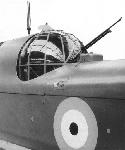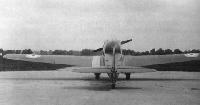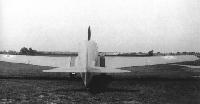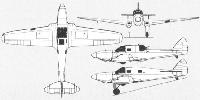
Описание
Страна : Великобритания
Год : 1937
Связной самолет с экипажем из одного/трех человек
de Havilland DH.93 Don
Военный вариант V-образного рядного двигателя de Havilland Gipsy Twelve, использовавшегося на DH.91, получил наименование Gipsy King и был предложен в качестве основы силовой установки многоцелевого учебного самолета, разработанного по спецификации T.6/36 Министерства авиации. DH.93 Don представлял собой свободнонесущий низкоплан деревянной конструкции с закрытой кабиной и убирающимися основными стойками шасси. Он был предназначен для подготовки пилотов, радистов и стрелков. Прототип поднялся в воздух 18 июня 1937 года и после заводских испытаний, в ходе которых самолет оснастили маленькими вспомогательными килями, был передан в Мартлешем Хит для проведения официальных испытаний. Потребовавшиеся модификации увеличили массу машины, в результате чего ряд тяжелого оборудования (включая турель Armstrong Whitworth) был с него снят. Из заказанных 250 самолетов успели изготовить 50, причем 20 из них оставались без двигателей, а остальные были переделаны в связные и использовались 24-й эскадрильей и рядом других подразделений.
ТАКТИКО-ТЕХНИЧЕСКИЕ ХАРАКТЕРИСТИКИ
de Havilland DH.93 Don
Тип: связной самолет с экипажем из одного/трех человек
Силовая установка: один рядный поршневой двигатель de Havilland Gipsy King I мощностью 525 л. с. (391 кВт)
Летные характеристики: максимальная скорость на высоте 2665 м - 304 км/ч; начальная скороподъемность 250 м/мин; потолок 7100 м; дальность полета 1432 км
Масса: пустого 2291 кг; максимальная взлетная 3112 кг
Размеры: размах крыла 14,48 м; длина 11,38 м; высота 2,87 м; площадь крыла 28,24 м2
Полезная нагрузка: до трех человек
- Описание
Фотографии
-
Air Enthusiast 2003-05 / D.Ford - Out-moded teacher
Регистрационный номер: L2387 [6] Prototype L2387 in 'B condition' markings and faired-over (or mock-up) turret after its first flight on June 18, 1937. The film used makes its overall yellow colour scheme look dark and the roundels 'reversed'.
-
Flight 1937-11 / Flight
But one outstanding characteristic of the De Havilland Don comprehensive trainer is the cooling system of the Gipsyking engine.
-
Flight 1937-12 / Flight
A fine example of a modern single-engined military trainer, the De Havilland Don, ordered in quantity by the Air Ministry, has the new Gipsy King engine.
-
Flight 1937-07 / Flight
Ordered in quantity for the R.A.F., the De Havilland Don advanced trainer is powered with one of the new D.H. Gipsyking inverted vee-twelves.
-
Flight 1937-06 / Flight
The De Havilland Don advanced trainer, ordered in quantity for the R.A.F., is fitted with the D.H. Gipsyking inverted vee-twelve engine, better known as the Gipsy Twelve.
-
Flight 1938-12 / Flight
Регистрационный номер: L2387 [6] Showing how the retracted wheels of the D.H. Don are housed in fairings behind the intakes for the cooling air.
-
Flight 1938-05 / Flight
Регистрационный номер: L2387 [6] Two modern trainers; The De Havilland Don with a single D.H. Gipsyking engine and the twin-engined Airspeed Oxford. Both machines are being flown by Martlesham test pilots.
Другие самолёты на фотографии: Airspeed Oxford / AS.10 - Великобритания - 1937
-
Air Enthusiast 2003-05 / D.Ford - Out-moded teacher
Регистрационный номер: L2387 [6] Close-up of the Lewis gun-equipped turret on the prototype Don. Note also the direction-finding loop.
-
Air Enthusiast 2003-05 / D.Ford - Out-moded teacher
Регистрационный номер: L2387 [6] Detail view of the prototype showing the auxillary fins fitted under the tailplane to this and all other Dons.
-
Air Enthusiast 2003-05 / D.Ford - Out-moded teacher
Регистрационный номер: L2387 [6] Rear view of the prototype with turret, July 1937.
-
Air Enthusiast 2003-05 / D.Ford - Out-moded teacher
Регистрационный номер: L2389 Rear view probably of L2389 in 'comms' format showing the large rear fairing, July 1938.
-
Flight 1939-03 / Flight
The De Havilland Don (D.H. Gipsyking engine) as employed for communication work and for certain types ol training in the R.A.F.
-
Air Enthusiast 2003-05 / D.Ford - Out-moded teacher
Регистрационный номер: L2391 [3] In its communications form, the Don was an elegant aircraft. The wing root leading edge intakes to cool the engine are apparent. Illustrated is the infortunate L2391 shortly after its first flight on June 13, 1938.
-
Мировая Авиация 105
Регистрационный номер: L2391 [3] Самолет L2391 - пятый серийный DH.93 Don. На этом снимке едва видны маленькие вспомогательные кили на оперении.
-
Flight 1938-10 / Flight
Регистрационный номер: L2393 [3] SANS TURRET: The D.H. Don appears in a new form - as a fast communications machine, for which purpose it is now being supplied in quantity to the R.A.F. With the 525 h.p. - for-take-off Gipsy Twelve (or Gipsyking, as it is designated for Service purposes; the Don has a top speed of 213 m.p.h., and cruises at 192 m.p.h. with 62 per cent, power at 11,000ft. One of the two engine-cooling ducts can be seen in the leading edge.
-
Flight 1939-05 / Flight
Регистрационный номер: L2393 [3] -
Air Enthusiast 2003-05 / D.Ford - Out-moded teacher
Регистрационный номер: L2393 [3] L2393 served with the Station Flight at Eastchurch. It first flew on March 12, 1938, and was relegated to an instructional airframe on March 17, 1939.
-
Air Enthusiast 2003-07 / Round-Out
Регистрационный номер: L2391 [3] DH.93 Don L2391's demise on September 22, 1938. While with the A&AEE at Martlesham Heath, its already overheating Gipsy King cut on approach and it overshoot.
-
Air Enthusiast 2003-05 / D.Ford - Out-moded teacher
De Havilland DH.93 Don.
- Фотографии





